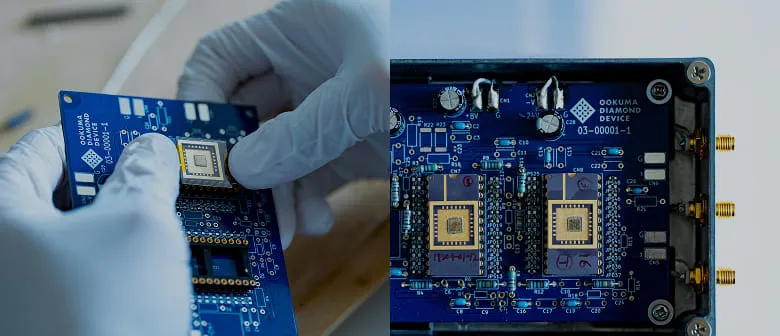Why Diamond Semiconductors,
and Why Now?

Diamond semiconductors,
the “ultimate semiconductor”
DIAMOND SEMICONDUCTOR
Diamond semiconductors, known as the “ultimate semiconductor” for their exceptional physical properties, are built on artificially synthesized diamond substrates. They deliver performance that conventional materials have never been able to achieve, particularly in the field of analog semiconductors.
Analog semiconductors connecting people and the digital world
The light we see, the sound we hear, and the temperature or pressure we feel—these are all forms of information from the real world that exist as continuously changing “analog signals.” Humans can only perceive such analog information, and sensors and devices also receive information first as analog signals. In contrast, electronic devices such as computers and smartphones can process information only in the form of digital signals composed of binary numbers.
Analog semiconductors serve as the bridge between the “real” and the “digital.” Though they often go unnoticed, they are indispensable, linking human senses with digital devices and acting as the gateway through which technology interprets and controls every aspect of the real world.

The more you pursue performance, the more it becomes constrained:
the structural dilemma of analog semiconductors
THE LIMITS OF ANALOG SEMICONDUCTOR

Digital technologies that are transforming society, such as AI and autonomous driving, are advancing exponentially in line with Moore’s Law.* In contrast, the analog semiconductors that connect these digital technologies to the real world are pushed harder as performance demands increase, leading to greater heat generation. As heat rises, more complex cooling systems are required, which in turn expand the overall size of the device and increase its power consumption, ultimately deviating from the original design goals. The result is a dilemma in which the very effort to improve performance forces it to be restrained, marking the inherent limitation of conventional analog semiconductors.
These material-based limitations have the potential to become a bottleneck for technological advancement across a wide range of fields. As analog semiconductors approach their “physical limits,” building the next generation of information infrastructure demands alternative materials that differ from those used in the past.
*What is Moore’s Law?
An empirical observation stating that “the number of transistors on a digital semiconductor chip doubles approximately every two years.” Proposed in 1965 by Gordon Moore, co-founder of Intel, it has been used as a benchmark for predicting improvements in computer performance.
Technology that achieves both performance beyond physical limits and a stable supply chain
WHY DIAMOND SEMICONDUCTOR IS THE BREAKTHROUGH
Overcoming the barriers of heat, power, and size that conventional semiconductors could never surpass—this is what our diamond semiconductors achieve by addressing these challenges at the material level. Diamond far outperforms existing materials in physical properties such as thermal conductivity, electric field breakdown strength, and carrier mobility. In particular, compared to GaN, which is increasingly being adopted in recent years, diamond semiconductors have the potential to deliver up to 6× higher output, temperature rise reduced by 66%, and enable over 80% miniaturization.
In recent years, the cost of synthetic diamond, the raw material, has been declining, making practical implementation increasingly feasible from a cost perspective.
Moreover, because synthetic diamond can be manufactured worldwide, it enables the creation of a geopolitically stable supply chain.
In this way, diamond semiconductors are a technology essential for opening a new era, one that achieves both superior performance beyond the limits of conventional materials and the balance of realistic cost and reliable supply.

Technology born from nuclear decommissioning to support next-generation infrastructure
UNLOCKING SOLUTIONS
TO GLOBAL CHALLENGES
The development of diamond semiconductors began as a response to the extreme conditions posed by the decommissioning of the Fukushima Daiichi Nuclear Power Plant. This technology, which overcomes the traditional limits of heat, power, and size, is also expected to serve as next-generation infrastructure supporting the ever-evolving digital technologies in fields such as space, security, and next-generation communications. Diamond semiconductors are set to become an indispensable part of society in the future.


